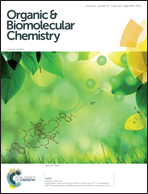Aggregation-induced emission enhancement upon Al3+ complexation with a tetrasulfonated calix[4]bisazacrown fluorescent molecular sensor†
Abstract
Aggregation-induced emission and aggregation-induced emission enhancement have attracted much attention due to their great potential in real-world applications. Up to now most of the reports are based on the restriction of free rotation of the luminogens in the aggregates. In the present work, we found that the dansyl fluorophore with typical intramolecular charge transfer characteristic also exhibited aggregation-induced emission enhancement, which was based on the change of micro-environmental polarity of the fluorophore. In the light of the phenomenon, a new water-soluble ligand bearing a tetrasulfonated calix[4]arene was constructed for ratiometric detection of Al3+ based on an aggregation-induced emission enhancement mechanism. It displayed a distinct selectivity to Al3+ among the tested cations in lutidine buffer solution (pH 6–7) with a detection limit of 1.8 μM. A reversible response was also demonstrated by the addition of EDTA or F−.
![Graphical abstract: Aggregation-induced emission enhancement upon Al3+ complexation with a tetrasulfonated calix[4]bisazacrown fluorescent molecular sensor](/en/Image/Get?imageInfo.ImageType=GA&imageInfo.ImageIdentifier.ManuscriptID=C4OB00187G&imageInfo.ImageIdentifier.Year=2014)

 Please wait while we load your content...
Please wait while we load your content...